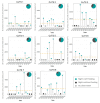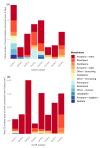Daily Variation in the Feeding Activity of Pacific Crown-of-Thorns Starfish (Acanthaster cf. solaris)
- PMID: 40906229
- PMCID: PMC12383361
- DOI: 10.3390/biology14081001
Daily Variation in the Feeding Activity of Pacific Crown-of-Thorns Starfish (Acanthaster cf. solaris)
Abstract
The ecological impact of crown-of-thorns starfish (CoTS; Acanthaster spp.) on coral reefs is intrinsically linked to their feeding behaviour. Management thresholds designed to mitigate coral loss driven by elevated densities of crown-of-thorns starfish rely on accurate estimates of individual feeding rates. In this study, structure-from-motion photogrammetry and intensive tracking of adult Pacific CoTS over an extended survey period were used to generate three-dimensional, high-resolution estimates of daily feeding rates. Our findings revealed substantial variation in the areal extent of coral consumed, both across consecutive days and among individuals. Notably, CoTS did not feed consistently; feeding occurred on 65% of observation days, with 2-3 days periods of inactivity common. Despite this variability, mean daily feeding rates aligned with previous studies (1.35 coral colonies d-1; 198.4 cm2 day-1 planar area, and 998.83 cm2 day-1 three-dimensional surface area). Across all tracked individuals (n = 8), feeding was recorded on 17 coral genera; however, Acropora alone accounted for 51% of colonies consumed and contributed 82% of the total three-dimensional surface area ingested during the survey period. This highlights the disproportionately large feeding yield derived from Acropora-dominated diets and raises important questions about how future declines in Acropora cover may impact CoTS feeding success and energetic intake.
Keywords: behaviour; coral reefs; disturbance; management.
Conflict of interest statement
The authors declare no conflicts of interest.
Figures





Similar articles
-
Maximising the benefits of local management for coral reefs amidst near-term environmental change.J Environ Manage. 2025 Sep;392:126627. doi: 10.1016/j.jenvman.2025.126627. Epub 2025 Jul 21. J Environ Manage. 2025. PMID: 40695189
-
In vivo induction of crown-of-thorns starfish (Acanthaster spp.) spawning using a synthetic relaxin-like gonad-stimulating peptide.Gen Comp Endocrinol. 2025 Aug 25;373:114804. doi: 10.1016/j.ygcen.2025.114804. Online ahead of print. Gen Comp Endocrinol. 2025. PMID: 40865776 Review.
-
Optimising crown-of-thorns starfish control effort on the Great Barrier Reef.PLoS One. 2025 Jul 15;20(7):e0302616. doi: 10.1371/journal.pone.0302616. eCollection 2025. PLoS One. 2025. PMID: 40663587 Free PMC article.
-
Crown-of-thorns seastar (Acanthaster spp.) feeding ecology across species and regions.Sci Total Environ. 2024 Jun 20;930:172691. doi: 10.1016/j.scitotenv.2024.172691. Epub 2024 Apr 23. Sci Total Environ. 2024. PMID: 38663591 Review.
-
Laboratory study on the relative predation rates of crown-of-thorns starfish (CoTS) larvae by five fish species.Sci Rep. 2025 Jul 4;15(1):23935. doi: 10.1038/s41598-025-07990-8. Sci Rep. 2025. PMID: 40615524 Free PMC article.
References
-
- Tkachenko K.S., Hoang D.T. Concurrent effect of crown-of-thorns starfish outbreak and thermal anomaly of 2020 on coral reef communities of the Spratly Islands (South China Sea) Mar. Ecol. 2022;43:e12717. doi: 10.1111/maec.12717. - DOI
-
- Seveso D., Stahl J.H., Landes A. An outbreak of Acanthaster spp. in the Gulf of Oman (United Arab Emirates) Mar. Biodivers. 2024;54:62. doi: 10.1007/s12526-024-01456-2. - DOI
-
- Pratchett M.S. Dynamics of an outbreak population of Acanthaster planci at Lizard Island, northern Great Barrier Reef (1995–1999) Coral Reefs. 2005;24:453–462. doi: 10.1007/s00338-005-0006-4. - DOI
-
- Miller I. Historical patterns and current trends in the broadscale distribution of crown-of-thorns starfish in the northern and central sections of the Great Barrier Reef; Proceedings of the 9th International Coral Reef Symposium; Bali, Indonesia. 23–27 October 2000;
Grants and funding
LinkOut - more resources
Full Text Sources
Miscellaneous

